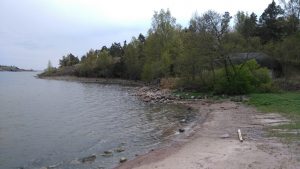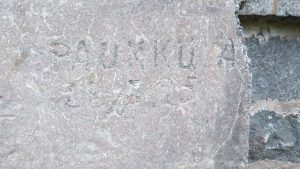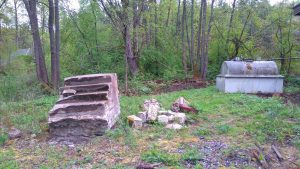Finnish Association of Forensic Archaeology and Anthropology (FAFAA) arranged an excursion to the Vallisaari and Kuninkaansaari fortress islands outside Helsinki on 14th of May, when the islands were opened to the public. Both islands used to be closed military areas and have a long martial history since the 17th century. FAFAA was expertly guided by archaeologist Mikko Suha on the islands.

Battery at Kuninkaansaari; note the icon stand of Russian soldiers from 19th century in the middle, left of Mikko Suha (Photo: Oula Seitsonen).
Islands have a large number of well-preserved fortifications especially from the 19th century, when Russian empire was building a fortification chain to protect the St. Petersburg. Islands saw military action especially during the Crimean War when an allied British-French naval task force bombed them and the neighbouring Suomenlinna fortification island in summer 1855.
Islands played also major role in the so-called Sveaborg rebellion of 1906, in the aftermath of the Russian Revolution of 1905. Revolutionary soldiers from the island’s Russian garrison mutinied and took hold of the Vallisaari and Kuninkaansaari islands. Rebels became disheartened by the bombardment of Imperial Russian Navy and a massive explosion of powder storage on Kuninkaansaari, and the mutiny was suppressed in four days. Revolutionary leaders were executed: one of them is told to still wander the island as a headless ghost, and during the island’s military period in 20th century the soldiers reportedly refused to stand in guard alone.

Shoreline shaped by the explosion of powder storage during the Sveaborg rebellion (Photo: Oula Seitsonen).
After Finnish independence of 1917 islands acted as major ammunition storage of Finnish Defence Forces, which use lasted until a few years ago. Ammunition, torpedoes, and mines were loaded and maintained in Vallisaari. Island is best known for a huge explosion in the so-called “Valley of Death” in 1937: tons of ammunition exploded, throwing material all the way to the mainland, and resulted in the death of 12 people. Cause of the explosion is unknown: it might have been due to careless handling of explosives, but also sabotage has been rumoured.
During the Second World War German troops established a radar station known as “Raija” at one artillery battery on the Kuninkaansaari island. After the war islands remained as restricted military areas, but Vallisaari was inhabited by the military personnel’s families: at most there were over 300 people on the tiny island, and there was school, shop, and other services. Last inhabitants moved from the island in 1996, after which the islands remained uninhabited, and now they are on a threshold of new life as an interesting tourist destination just outside the center of Helsinki.

Mikko Suha presenting a photograph of the German Second World War radar station to Tiina Mikkanen at its former place at Kuninkaansaari (Photo: Oula Seitsonen).


